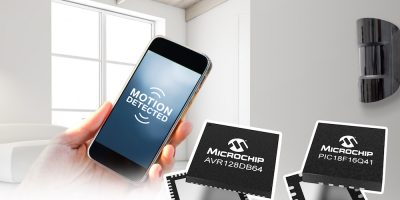Sensor-based IoT applications use a combination of analogue functionality and digital control capability to meet cost, size, performance and power parameters for efficiency. In response, Microchip has combined analogue peripherals and multi-voltage operation with inter-peripheral connections in its PIC18-Q41 and AVR DB MCU families. In addition to these attributes for increased system integration and reduced signal acquisition times, they offer the convenience and efficiency of operating in a single design environment, says Microchip.
The introduction bring s easy-to-use analogue capability to cost-effective PIC and AVR MCUs, says Greg Robinson, so designers can meet the requirements of large-scale IoT systems,” said Greg Robinson, associate vice president of marketing for Microchip’s 8-bit microcontroller business unit. “With a unified, seamless development tool experience, designers can use these MCUs as a single-chip controller, or as an intelligent analogue signal conditioning component in a larger system,” he explained.
The PIC18-Q41 MCU has a configurable operational amplifier and ADC with computation and DACs for signal conditioning in space-constrained sensing and measuring applications such as IoT end nodes and industrial, medical devices, wearables, automotive and lighting systems. It is also well-suited for IoT and large-scale artificial intelligence (AI) at the edge, including predictive maintenance edge nodes in a smart factory, added Microchip. It is offered in compact 14- and 20-pin packages and can be used with Microchip’s 32-bit MCUs and other controllers that require analogue integration.
For mixed-signal IoT systems which often include multiple power domains, the AVR DB MCU integrates true bi-directional level shifters to reduce cost. Typical use examples are automotive, appliances, HVAC and liquid measurement applications. Microchip has added three configurable op amps, a 12-bit differential ADC, 10-bit DAC, three zero cross detectors and Core Independent Peripherals (CIPs) enabling the AVR DB MCU to be used wherever analogue signal conditioning and processing functions are required.
The PIC18-Q41 and AVR DB MCU families are supported by Microchip’s MPLAB X integrated development environment (IDE), its MPLAB Code Configurator (MCC) and the MPLAB Mindi Analog Simulator. MCC is a free software plug-in that provides a graphical interface to configure peripherals and functions specific to an application.
The AVR DB is additionally supported by Atmel START, Atmel Studio and third-party tools such as IAR and the GCC C compiler.
The PIC18F16Q41 Curiosity Nano evaluation kit (EV26Q64A) and the AVR DB Curiosity Nano evaluation kit (EV35L43A) are also available with programming and debugging capabilities.







